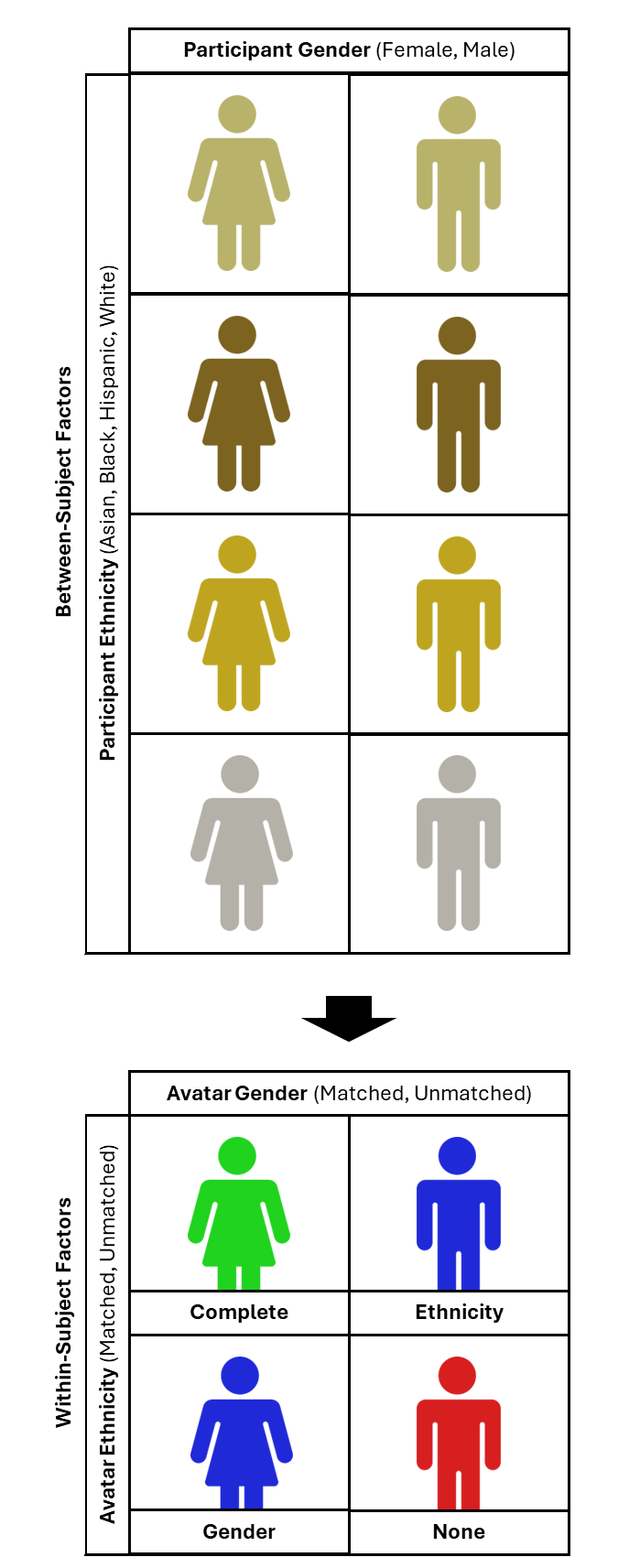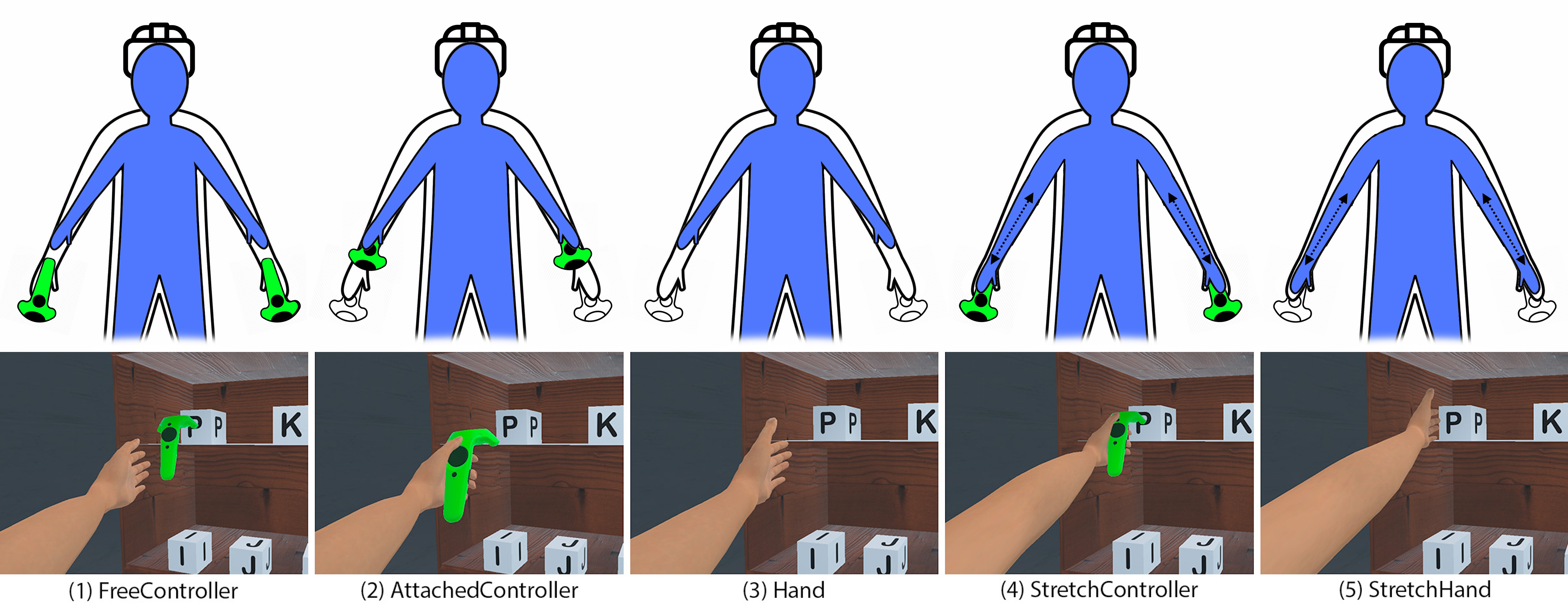Stepping into the Right Shoes: The Effects of User-Matched Avatar Ethnicity and Gender on Sense of Embodiment in Virtual Reality

0
🏅
Sign in to get full access
Overview
- This research explores whether matching a user's physical characteristics, specifically ethnicity and gender, with their virtual self-avatar affects their sense of embodiment in virtual reality (VR).
- The study conducted a 2 x 2 within-subjects experiment with a diverse user population to investigate the impact of matching or not matching a user's self-avatar to their ethnicity and gender.
- The findings indicate that matching the ethnicity of the user and their self-avatar significantly enhances the user's sense of embodiment, while matching gender specifically affects body ownership.
Plain English Explanation
In many VR applications, users control pre-designed characters with limited customization options, often prioritizing storytelling over user choice. This research explores whether having a virtual self-avatar that matches the user's ethnicity and gender can impact their sense of embodiment, or the feeling of being present in the virtual environment.
The researchers conducted an experiment where participants interacted with a virtual self-avatar that either matched or did not match their ethnicity and gender. They found that when the virtual self-avatar matched the user's ethnicity, the user felt a stronger sense of embodiment, including a greater sense of the virtual body being their own and the virtual actions feeling more natural and responsive.
Additionally, the study found that matching the user's gender specifically affected their sense of body ownership, or the feeling that the virtual body belongs to them. This suggests that both ethnicity and gender play a role in shaping the user's sense of embodiment in VR.
The researchers believe these findings have important implications for the design of VR experiences, as creating virtual self-avatars that closely reflect the user's physical characteristics can enhance their sense of presence and immersion in the virtual world. This could lead to more engaging and meaningful VR experiences for users.
Technical Explanation
The researchers conducted a 2 x 2 within-subjects experiment with 32 participants from a diverse user population. The experiment explored the impact of matching or not matching a user's self-avatar to their ethnicity and gender on their sense of embodiment in VR.
Participants were randomly assigned to one of four conditions: 1) ethnicity and gender matched, 2) ethnicity matched, gender not matched, 3) ethnicity not matched, gender matched, and 4) ethnicity and gender not matched. After experiencing each condition, participants completed questionnaires to assess their sense of embodiment, including aspects such as appearance, response, and ownership.
The results showed that matching the ethnicity of the user and their self-avatar significantly enhanced the user's sense of embodiment, regardless of gender. This effect was observed across various aspects of embodiment, including appearance, response, and ownership.
Additionally, the researchers found that matching gender specifically affected body ownership, suggesting that this aspect of embodiment is influenced by matching both ethnicity and gender. Interestingly, they also discovered that matching ethnicity specifically impacts self-location, while matching gender specifically affects body ownership.
These findings contribute to the understanding of how user characteristics influence embodiment in VR and build upon previous research on the effects of realism and representation in self-embodied avatars and the impact of self-avatar controller design.
Critical Analysis
The research provides valuable insights into the role of user characteristics in shaping their sense of embodiment in VR. However, the study does have some limitations that should be considered.
First, the experiment was conducted with a relatively small sample size of 32 participants. While the findings are statistically significant, a larger and more diverse sample could strengthen the generalizability of the results.
Additionally, the study focused on ethnicity and gender as the primary physical characteristics of interest. Other factors, such as age, body type, or disability, may also play a role in embodiment and could be explored in future research.
The researchers also acknowledge that the study did not investigate the potential effects of incongruencies between the user's physical appearance and the virtual self-avatar. Exploring how such incongruencies impact embodiment could provide further insights.
Furthermore, the study did not examine the long-term effects of using a matched or mismatched self-avatar on the user's sense of embodiment. Longitudinal research could shed light on how the user's experience evolves over time.
Overall, this research represents an important step in understanding the role of human-embodied AI in virtual social interactions and highlights the significance of considering user characteristics in the design of VR experiences.
Conclusion
This study demonstrates that matching the ethnicity and gender of a user's virtual self-avatar can significantly enhance their sense of embodiment in VR. By providing users with virtual representations that closely reflect their physical characteristics, the researchers found that users experienced a stronger connection to the virtual environment and a greater sense of ownership over their virtual body.
These findings have important implications for the design of VR applications, as creating more personalized and inclusive virtual experiences can lead to increased user engagement, immersion, and satisfaction. As VR technology continues to evolve, considering the impact of user characteristics on embodiment will be crucial for developing VR experiences that are truly responsive to the diverse needs and preferences of the users.
This summary was produced with help from an AI and may contain inaccuracies - check out the links to read the original source documents!
Related Papers
🏅

0
Stepping into the Right Shoes: The Effects of User-Matched Avatar Ethnicity and Gender on Sense of Embodiment in Virtual Reality
Tiffany D. Do, Camille Isabella Protko, Ryan P. McMahan
In many consumer virtual reality (VR) applications, users embody predefined characters that offer minimal customization options, frequently emphasizing storytelling over user choice. We explore whether matching a user's physical characteristics, specifically ethnicity and gender, with their virtual self-avatar affects their sense of embodiment in VR. We conducted a 2 x 2 within-subjects experiment (n=32) with a diverse user population to explore the impact of matching or not matching a user's self-avatar to their ethnicity and gender on their sense of embodiment. Our results indicate that matching the ethnicity of the user and their self-avatar significantly enhances sense of embodiment regardless of gender, extending across various aspects, including appearance, response, and ownership. We also found that matching gender significantly enhanced ownership, suggesting that this aspect is influenced by matching both ethnicity and gender. Interestingly, we found that matching ethnicity specifically affects self-location while matching gender specifically affects one's body ownership.
Read more7/16/2024


0
Cultural Reflections in Virtual Reality: The Effects of User Ethnicity in Avatar Matching Experiences on Sense of Embodiment
Tiffany D. Do, Juanita Benjamin, Camille Isabella Protko, Ryan P. McMahan
Matching avatar characteristics to a user can impact sense of embodiment (SoE) in VR. However, few studies have examined how participant demographics may interact with these matching effects. We recruited a diverse and racially balanced sample of 78 participants to investigate the differences among participant groups when embodying both demographically matched and unmatched avatars. We found that participant ethnicity emerged as a significant factor, with Asian and Black participants reporting lower total SoE compared to Hispanic participants. Furthermore, we found that user ethnicity significantly influences ownership (a subscale of SoE), with Asian and Black participants exhibiting stronger effects of matched avatar ethnicity compared to White participants. Additionally, Hispanic participants showed no significant differences, suggesting complex dynamics in ethnic-racial identity. Our results also reveal significant main effects of matched avatar ethnicity and gender on SoE, indicating the importance of considering these factors in VR experiences. These findings contribute valuable insights into understanding the complex dynamics shaping VR experiences across different demographic groups.
Read more7/16/2024


0
Effects of Realism and Representation on Self-Embodied Avatars in Immersive Virtual Environments
Rafael Kuffner dos Anjos, Jo~ao Madeiras Pereira
Virtual Reality (VR) has recently gained traction with many new and ever more affordable devices being released. The increase in popularity of this paradigm of interaction has given birth to new applications and has attracted casual consumers to experience VR. Providing a self-embodied representation (avatar) of users' full bodies inside shared virtual spaces can improve the VR experience and make it more engaging to both new and experienced users . This is especially important in fully immersive systems, where the equipment completely occludes the real world making self awareness problematic. Indeed, the feeling of presence of the user is highly influenced by their virtual representations, even though small flaws could lead to uncanny valley side-effects. Following previous research, we would like to assess whether using a third-person perspective could also benefit the VR experience, via an improved spatial awareness of the user's virtual surroundings. In this paper we investigate realism and perspective of self-embodied representation in VR setups in natural tasks, such as walking and avoiding obstacles. We compare both First and Third-Person perspectives with three different levels of realism in avatar representation. These range from a stylized abstract avatar, to a realistic mesh-based humanoid representation and a point-cloud rendering. The latter uses data captured via depth-sensors and mapped into a virtual self inside the Virtual Environment. We present a throughout evaluation and comparison of these different representations, describing a series of guidelines for self-embodied VR applications. The effects of the uncanny valley are also discussed in the context of navigation and reflex-based tasks.
Read more5/7/2024


0
Stretch your reach: Studying Self-Avatar and Controller Misalignment in Virtual Reality Interaction
Jose Luis Ponton, Reza Keshavarz, Alejandro Beacco, Nuria Pelechano
Immersive Virtual Reality typically requires a head-mounted display (HMD) to visualize the environment and hand-held controllers to interact with the virtual objects. Recently, many applications display full-body avatars to represent the user and animate the arms to follow the controllers. Embodiment is higher when the self-avatar movements align correctly with the user. However, having a full-body self-avatar following the user's movements can be challenging due to the disparities between the virtual body and the user's body. This can lead to misalignments in the hand position that can be noticeable when interacting with virtual objects. In this work, we propose five different interaction modes to allow the user to interact with virtual objects despite the self-avatar and controller misalignment and study their influence on embodiment, proprioception, preference, and task performance. We modify aspects such as whether the virtual controllers are rendered, whether controllers are rendered in their real physical location or attached to the user's hand, and whether stretching the avatar arms to always reach the real controllers. We evaluate the interaction modes both quantitatively (performance metrics) and qualitatively (embodiment, proprioception, and user preference questionnaires). Our results show that the stretching arms solution, which provides body continuity and guarantees that the virtual hands or controllers are in the correct location, offers the best results in embodiment, user preference, proprioception, and performance. Also, rendering the controller does not have an effect on either embodiment or user preference.
Read more7/12/2024